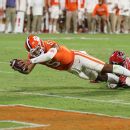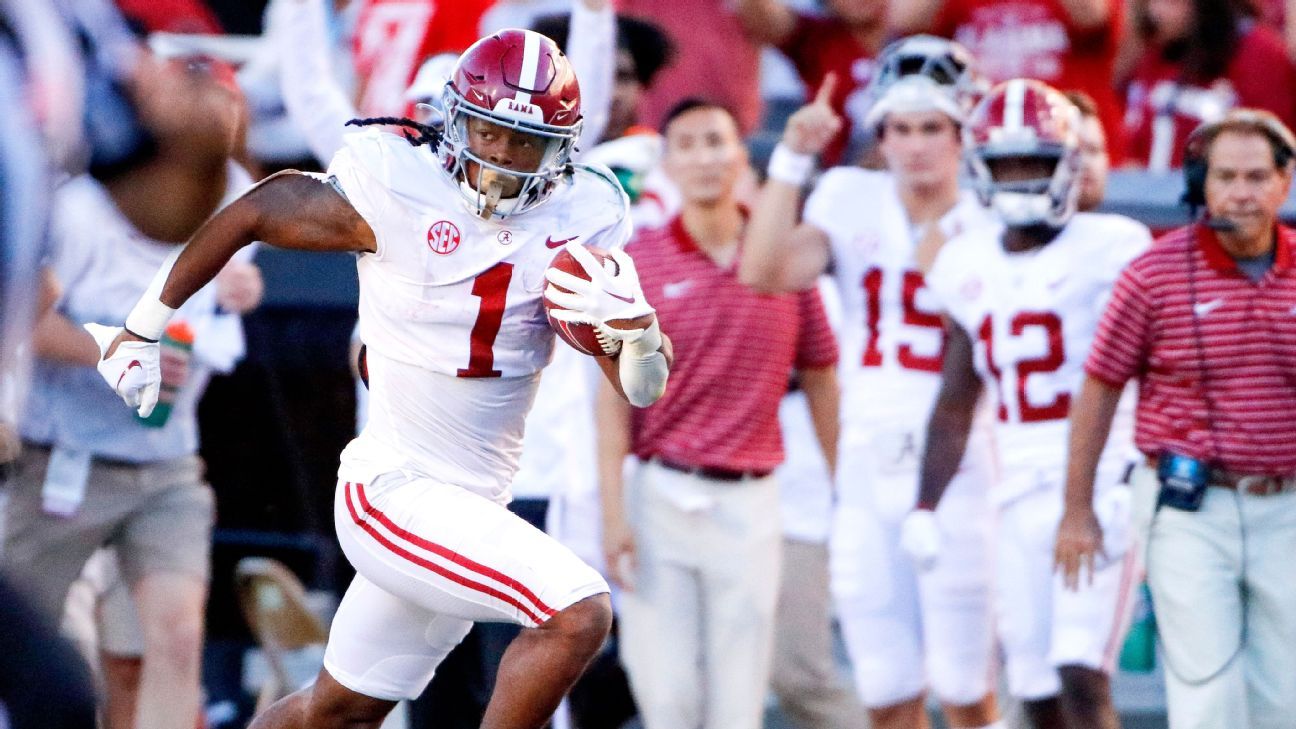
TYLER SISKEY WANTS to be clear: He doesn’t think Alabama coach Nick Saban is hypocritical when he says something is bad for college football and then goes out and does the exact thing he was complaining about. Siskey, who worked for Saban in his player personnel department from 2013 to ’14, knows his former boss to be a pragmatic man.
So when Saban raised a red flag about the unintended consequences of the transfer portal back in 2019, Siskey heard genuine concern for the state of the sport. Parity might be a myth in the modern NCAA, but it’s a myth Saban holds dear. And the portal, to Saban’s way of thinking, threatens the notion of competitive balance because it allows programs to poach players from struggling teams.
“So is that going to make the rich get richer?” Saban asked reporters during a news conference last year. “I don’t know.”
To Siskey and those connected to Alabama over the past decade, Saban’s question doubled as a warning — one he’d heard before.
“He’s telling you the truth about this not being a good thing,” Siskey said. “But he’s got the rules and he’s going to follow them.”
What’s more, Siskey added, Saban is adept at turning rules into an advantage.
“You know, he didn’t like spread offenses, either,” Siskey continued. “But you see what they’ve done.”
Saban once looked at the proliferation of spread offenses — with their quick tempo and offensive linemen running downfield — and asked, “Is this what we want football to be?” He was roundly mocked at the time. But then he went out and hired Lane Kiffin as offensive coordinator and told him to put his foot on the gas. Almost overnight, Alabama started producing some of the most dynamic offenses in college football.
“If that’s how the game’s going to be played,” Siskey said, “he’s going to play it.”

1 Related
And he’s probably going to play it better than anyone. While Saban might dislike what the portal is doing to college football, that didn’t stop him from mastering it this past offseason, using it like NFL free agency but without a pesky salary cap. Forget taking unproven talent or drafting from the lower levels of football. He aimed higher.
When offensive tackle Evan Neal, running back Brian Robinson Jr., cornerback Josh Jobe and receivers John Metchie and Jameson Williams left via the NFL draft after last season, Alabama replaced them with proven Power 5 players. It signed offensive tackle Tyler Steen, who started 33 consecutive games at Vanderbilt; running back Jahmyr Gibbs, an All-ACC selection at three different positions at Georgia Tech; cornerback Eli Ricks, a former top-50 prospect and All-American at LSU; and wide receivers Jermaine Burton and Tyler Harrell, starters and high-level producers at Georgia and Louisville, respectively.
Siskey laughs at the absurdity of such a haul. Gibbs is playing his way into Heisman Trophy consideration after racking up 206 yards and two touchdowns against Arkansas last Saturday.
“Saban’s the best at what he does for a reason, right?” Siskey said.
A COLLEGE HEAD coach in the Southeast leans back in his chair and points to a cell phone sitting face up on his desk. Every day, he says, he gets calls on behalf of college players around the country — from former high school coaches, from trainers, from so-called mentors. He recounts the gist of every conversation: “Hey, So and So isn’t happy there.”
It’s the first month of the college football season, the transfer window is closed to non-graduates, but players are already shopping outside the portal for potential destinations. The coach says there are all these “underground connections” that lead to players’ next schools. “How tangled up that is, you go, ‘Whoa,'” he says.
Take Alabama. Steen went to the same high school in South Florida as safety Jordan Battle and outside linebacker Dallas Turner. Burton knew quarterback Bryce Young from California. Ricks played with Young at Mater Dei High School.
Gibbs, it turns out, was originally recruited by Alabama out of Dalton High School in Georgia. He was also offered a scholarship and recruited by North Carolina running backs coach Robert Gillespie, who joined the Alabama staff in 2021.
A Georgia Tech source said the staff was deflated when it learned that Gibbs — the team’s most talented player — was planning to leave. But they didn’t get the sense he was entering the portal for money via name, image and likeness opportunities. “The kid just wanted to win,” the source said.
But that same source said the transfer landscape is changing and growing more “out of control” with personnel departments keeping lists of potential transfer targets with geographical or personal connections to the team.
Less than two years ago, when the NCAA allowed players to transfer once with immediate eligibility and the portal exploded with activity, coaches were worried about what’s known in basketball as transferring up: players moving from Division II to Division I or from the Group of 5 to the Power 5. But blue bloods like Alabama are showing movement can happen at the highest levels, too.
Jordan Addison won the Biletnikoff Award at Pitt and entered the portal in May. He and Bryce Young worked out in California while he was in transfer limbo. Alabama even made overtures about bringing him to Tuscaloosa, sources said, but it never got far because he was intent on joining USC and its new coach Lincoln Riley.
Pitt coach Pat Narduzzi wasn’t happy with Riley for how the Addison saga unfolded. But Narduzzi was hardly alone in questioning the transfer process. Louisville coach Scott Satterfield suggested to 247Sports that Harrell was tampered with after he left for Alabama; Saban denied any wrongdoing.
A Power 5 assistant said the game has changed. “The whole goal of the postgame handshake,” he said, “is to start recruiting the other team.”
The paranoia is real, and quick commitments after a player enters the portal further fuel speculation.
On Jan. 10, Alabama lost to Georgia in the national championship game. Eight days later, Burton entered the portal. And four days after that, he announced he was joining Alabama.
In February, Saban addressed his use of the portal. He said that Burton “had some production this year” at Georgia.
Then he paused and shrugged.
Burton had 26 catches for 497 yards yards and 5 touchdowns.
“But [he] probably might have seen a better opportunity because we’re a little more wide open and throw the ball more with a good quarterback,” Saban added. “That may have been his intention.”
When Burton finally did speak to reporters this summer, he said he had moved on from Georgia and the championship.
“I honestly forgot about that game. I want to win with this team.”
LAST YEAR, MISSOURI coach Eliah Drinkwitz tried to peer into the future.
“We’re about two steps into a mile race,” he said of the transfer portal, “and I don’t think anyone knows the pace and I don’t think anyone knows the strategy and I don’t think anyone knows what the rules will be when this ends.”
Long story short: No one knows, or at least no one has settled on what’s the right thing to do.
The NCAA established windows of transfer activity in August, but that’s just a way of damming a river and pretending there’s not pressure building up on the other side. Because there most certainly is.
Strategies have varied wildly from one school to another. Georgia didn’t take a single transfer this offseason. Ole Miss took more than a dozen.
Siskey, who also spent time on staffs at Ole Miss and Arkansas State, expects Alabama to continue to be selective. “They don’t have to stretch for a guy in the portal,” he said, because Saban and his staff recruit high schools at such a high level; the Tide have finished in the top three of ESPN’s class rankings every year since 2008. Schools similarly flush with four- and five-star prospects — Ohio State, Clemson and the like — can instead use the portal as a supplement, filling gaps when a player leaves early for the NFL draft.
Leaning on the free agency analogy, Siskey said there are most often two motivating factors when it comes to players signing their next contracts: money and the ability to win a championship.
At Alabama, he said, there’s no need to sacrifice one for the other.
The Crimson Tide have won six national championships since 2009. No other team has won more than two during that time.
NIL, Saban said, is “not an issue for us.” He claimed players earned more than $3 million in name, image and likeness deals last season.
Siskey pointed to future earnings as another metric. This April, Saban claimed Alabama players have earned $1.7 billion in the NFL.
Steen got his degree from Vanderbilt and said he was looking for something new when he decided to transfer after last season.
And while adjusting to a new playbook, a new locker room and a new culture at Alabama isn’t easy, it appears to have been a successful transition. He has started every game at left tackle.
Steen said he has embraced the “different expectations” at his new home and how many people push him to reach his full potential.
“It’s different over here for sure.”












